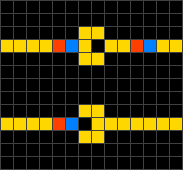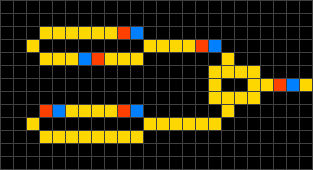Wireworld

Wire World is a cellular automaton , the first of Brian Silverman in 1987 in his program Phantom Fish Tank was used and later by an article in the column Computer Recreations of Scientific American was more widespread. Wireworld is particularly suitable for simulating electronic logic elements such as gates or flip-flops . Despite the simplicity of its rules (see below), Wireworld is Turing-complete , ie you can even use it to create complete computers (see also web link).
regulate
A Wireworld cell can have four different states (the specified color is used in the animated graphics on this page):
- black stands for empty
- yellow stands for "electrical conductor"
- blue stands for "electron head"
- red stands for "electron end"
Time passes in discrete steps, the so-called generations. An empty cell always remains empty. The other cells behave as follows during the transition from one generation to the next:
- An electron head becomes an electron end.
- One end of the electron becomes a conductor.
- A conductor becomes an electron head when exactly one or two of the neighboring cells are electron heads. The so-called Moore neighbors are considered to be adjacent, i.e. all cells that surround the conductor, including those only diagonally adjacent.
Applications
If these rules are applied to the following arrangement of cells, the electron moves one position to the right with each generation change ( = conductor, # electron end, @ electron head):
Generation n ====#@========
Generation n + 1 =====#@=======
Generation n + 2 ======#@======
By suitably designing conductor branches and crossings, logical switching elements can be implemented from simple gates to complex arithmetic units .
The picture on the left shows the implementation of two clock generators (left half of the picture) and an exclusive-or gate (right). The clock generators are designed as ring-shaped conductor tracks in which two electrons rotate at different distances. At the branches on the right edge of the rings, copies of these electrons are emitted into the conductor tracks leading to the inputs of the exclusive-or gate. The clock generators are coordinated in such a way that either a single electron enters the exclusive-or gate from above or below (it is let through), or two electrons arrive at the gate at the same time - they "destroy" each other and at the gate output no electron escapes. Thus a is XORing of the incoming to the gate inputs electron realized.
Signals
In Wireworld there are different codings for the transmission of data. What they all have in common is that an overall signal is divided into blocks of equal length. Coding with the block length n is called " n- micron" or " n- tick" coding.
In the so-called real codes, a logical 0 is represented by an empty block and a 1 by a block with an electron at the beginning. The minimum block length is 3, since there must always be at least one field distance between two electrons. In the complex codes, a 1 is represented as usual by an electron at the beginning of the block, a 0, however, not by an electron but by an electron delayed by one generation. Here the minimum block length is 4. Usually one uses
- 6 micron real
- 4 micron real
- 4 micron complex
- 3 micron real
The codings with a smaller block size are faster, but may require more complex circuits.
See also
- Conway's game of life
- There is a Wireworld implementation of Langton's ant ; it is included in the Golly sample pattern.
